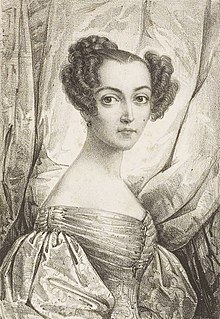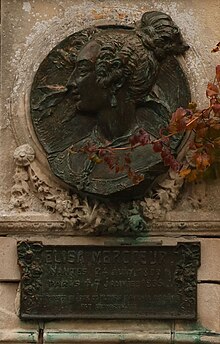fiction.wikisort.org - Writer
Élisa Mercœur (24 June 1809 in Saint-Sébastien-sur-Loire, 7 January 1835 in Paris) was a French writer, poet and essayist.[1] Mercœur was largely forgotten after her death. Her mother posthumously edited her work to ensure it survived for posterity, yet during her lifetime, Mercœur was known as the "La Muse armoricaine" (The Armorican Muse) and she was widely known throughout France.[2]
Élisa Mercœur | |
|---|---|
 Élisa Mercœur by Auguste Belin. | |
| Born | 24 June 1809 Saint-Sébastien-sur-Loire, Nantes |
| Died | 7 January 1835 (aged 25) Paris |
| Resting place | Père-Lachaise Cemetery |
| Occupation | Writer, Poet, Essayist |
| Nationality | French |
Life
Mercoeur's mother was Adèlaïde (or Adèle) Aumand, an embroiderer who was born in 1780 in Nantes. Her father was Jules-François Barré, a solicitor in the Vendée department of the Les Landes-Genusson region.[3] As the couple were unable to afford to look after their baby, her mother abandoned Mercoeur, when she was only three days old. On 27 June 1809 at 10pm, the baby was taken in at the door of the Nantes Orphans' Hospice (Hospice des Orphelins, Nantes),[4] located in the Saint-Clément district near the lycée and La Bouteillerie cemetery, by Jean Favret, an employee of the orphanage.[3] The baby carried a piece of paper with these words:
- "Élisa, born 24 June 1809, not registered in civil acts. Heaven and gentle humanity will watch over her. Her parents may be happy enough to claim her one day."
At 4 p.m. on 28 June, Jean Favret presented the baby to Police Commissioner Sébastien-Barthélemy Benoist, who was primarily responsible for orphans in the Lycée district, and who, in view of the information presented, gave her the name Élisa Mercœur.[3] The baby was then taken to the orphanage.
Analysis
Published work
The complete works of Élisa Mercœur were published by her mother under this general title: "Œuvres complètes de Mlle Élisa Mercœur, précédées de Mémoires et notices sur la vie de l'auteur, écrites par sa mère"6 . In addition to her poetry, these volumes contain: Boabdil, a tragedy in five acts; Louis XI et le Bénédictin, a fifteenth-century chronicle; les Italiennes; les Quatre amours; Louis XIII, and some other novels and short stories.
- Élisa Mercœur; Adélaïde Aumond Mercœur; Achille Devéria; François-René de Chateaubriand (1843). Oeuvres complètes d'Elisa Mercoeur de Nantes. T. 1 / précédées de mémoires et notices sur la vie de l'auteur, écrits par sa mère ; ornées d'un très beau portrait, par A. Deveria, et de trois fac-simile, dont l'un d'Élisa Mercoeur, et les deux autres de MM. de Chateaubriand et de Martignac [Complete works of Elisa Mercoeur de Nantes. T. 1 / preceded by memoirs and notes on the author's life, written by her mother; decorated with a beautiful portrait, by A. Deveria, and three facsimiles, one of which is by Elisa Mercoeur, and the other two by MM. de Chateaubriand and de Martignac] (in French). Paris. OCLC 1254585341. Vol. 2 OCLC 1254585716. Vol. 3 OCLC 1254585715
Awards and honours

There are streets called Rue Élisa Mercœur that are named in honour of Mercœur in Rennes, Vertou, Saint-Sébastien-sur-Loire. The street named Rue Élisa Mercœur in Nantes does not refer to this Mercœur but to the Philippe Emmanuel, Duke of Mercœur, the ultra-Catholic governor of the city from 1582 to 1598, at the end of the French Wars of Religion. There is an avenue named Avenue Élisa Mercœur in Champigny-sur-Marne and a square, Square Élisa-Mercœur in Nantes.[7] Lastly there is a small dead-end street in Séné called the Allée Élisa Mercœur.
Bibliography
Books
- Mercoeur, Élisa (1829). Poésies de Mlle Élisa Mercoeur (de Nantes). 2e édition augmentée de nouvelles pièces [Poetry of Mlle Elisa Mercoeur (of Nantes). 2nd edition] (in French) (2nd ed.). Paris: Crapelet. OCLC 461366497.
- Mercoeur, Élisa (1827). Poésies de Mlle Élisa Mercoeur (in French). Nantes: Impr. de Mellinet-Malassi. OCLC 457686917.
- Mercœur, Élisa (1827). Bisson (in French). Nantes: Impr. de Mellinet-Malassis. OCLC 457686908.
- Mercoeur, Élisa. La comtesse de Villequier (in French). OCLC 459484526.
- Mercœur, Élisa (1833). "La dernière feuille". In Hugo (1798-1855), Abel (ed.). Le conteur (in French). Paris: M. A. Hugo.
- Gabrielle, Soumet (1834). Le livre rose : Récits et causeries de jeunes femmes. Tome troisième. La cloche de Saint-Bruno, chapitre deuxième d'un ouvrage inédit (in French). Paris: U. Canel. OCLC 459363374.
- Élisa Mercœur; Adélaïde Aumond Mercœur; Achille Devéria; François-René de Chateaubriand (1843). Oeuvres complètes d'Elisa Mercoeur de Nantes. T. 1 / précédées de mémoires et notices sur la vie de l'auteur, écrits par sa mère ; ornées d'un très beau portrait, par A. Deveria, et de trois fac-simile, dont l'un d'Élisa Mercoeur, et les deux autres de MM. de Chateaubriand et de Martignac [Complete works of Elisa Mercoeur de Nantes. T. 1 / preceded by memoirs and notes on the author's life, written by her mother; decorated with a beautiful portrait, by A. Deveria, and three facsimiles, one of which is by Elisa Mercoeur, and the other two by MM. de Chateaubriand and de Martignac] (in French). Paris. OCLC 1254585341.
Musical compositions
References
- Greenberg, Wendy N. (1992). "Elisa Mercoeur: The Poetics Of Genius". Romance Notes. University of North Carolina at Chapel Hill. 33 (3): 207–215.
- Greenberg, Wendy N. (1995). "Elisa Mercœur: The Poetics of Genius and the Sublime". Nineteenth-Century French Studies. University of Nebraska Press. 24 (1/2): 84–96. JSTOR 23536928.
- Caillaud, Paul (1952). "La vie inquiète d'Élisa Mercœur". Annales de Bretagne. 59 (1): 28–38. doi:10.3406/abpo.1952.4356.
- Savariau, Maurice. "L'hôpital des orphelins de Nantes (1783-1815)" (pdf). Centre Hospitalier Universitaire de Nantes (in French). Nantes: Nantes Université. Retrieved 17 August 2022.
- Claretie, Jules (1864). Élisa Mercoeur, Hippolyte de la Morvonnais, George Farcy, Charles Dovalle, Alphonse Rabbe. Paris: Librairie De Mme Bachelin-Deflorenne.
- Paliyenko, Adrianna M. (2016). "The Other History of French Poetry, 1801–1900". Genius envy : women shaping French poetic history, 1801-1900. University Park, Pennsylvania. pp. Penn State University Press. ISBN 978-0-271-07708-6.
- Geoffroy, Daniel (1990). Elisa Mercœur: nantaise romantique (in French). Maulevrier, France: Hérault. p. 266.
External links
- Research resource: La France savante
- Entries in general dictionaries or encyclopedias
 Media related to Élisa Mercœur at Wikimedia Commons
Media related to Élisa Mercœur at Wikimedia Commons Works related to Élisa Mercœur at Wikisource (in French)
Works related to Élisa Mercœur at Wikisource (in French)
На других языках
- [en] Élisa Mercœur
[fr] Élisa Mercœur
Élisa Mercœur, née vraisemblablement à Saint-Sébastien-sur-Loire le 24 juin 1809 et morte à Paris le 7 janvier 1835, est une poétesse française.[ru] Меркёр, Элиза
Элиза́ Меркёр (фр. Élisa Mercœur; 24 июня 1809 года, Сен-Себастьян-сюр-Луар — 7 января 1835 года, Париж) — французская поэтесса.Другой контент может иметь иную лицензию. Перед использованием материалов сайта WikiSort.org внимательно изучите правила лицензирования конкретных элементов наполнения сайта.
WikiSort.org - проект по пересортировке и дополнению контента Википедии